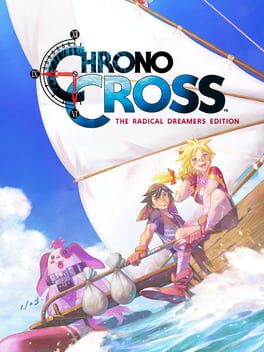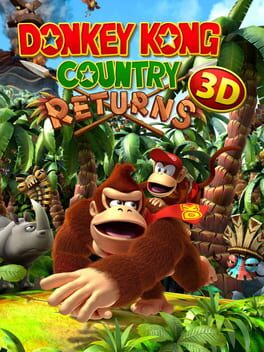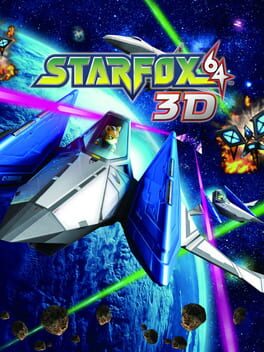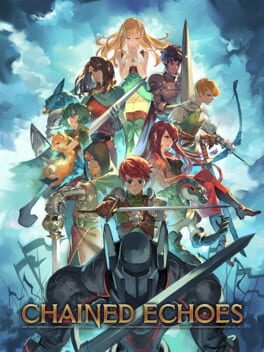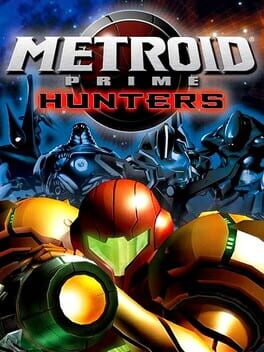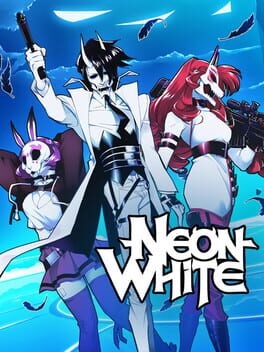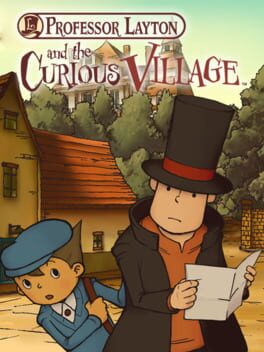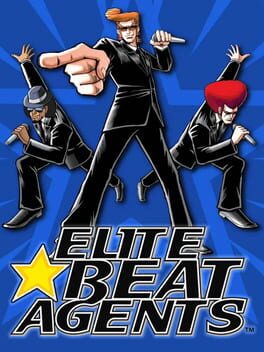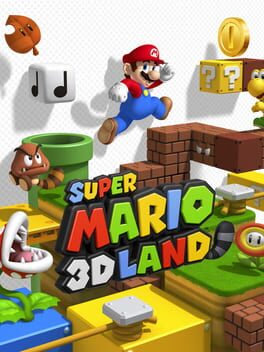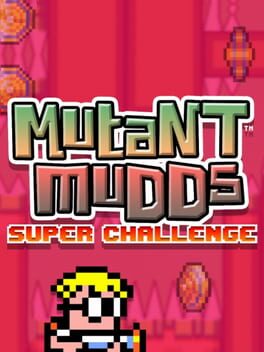ann3lid
2014
The conceit of this game is really smart. A game that teaches you how to draw by getting you to illustrate increasingly complex pokemon tcg cards. As a person intimidated by the idea of learning how to draw, this game does a pretty nice job of slowly introducing techniques without overwhelming you. My favorite aspect of this game is your "rival" who's drawings are in the game to make you feel better about your own.
The only thing that ultimately got me to put this down was the limiting technology of the 3ds. At the time of its release, I'm sure it inspired many budding artists, but working on ~4 in. screen with a pretty low resolution and a tiny stylus became taxing at a certain point.
The only thing that ultimately got me to put this down was the limiting technology of the 3ds. At the time of its release, I'm sure it inspired many budding artists, but working on ~4 in. screen with a pretty low resolution and a tiny stylus became taxing at a certain point.
A port of an already fantastic platformer that adds some quality of life features to improve it even more. As a revival of the classic DKC franchise, it gets what made the originals so great (challenging platforming, a vibrant score), but refreshes the formula for a modern audience. One of the best platformers for the 3ds.
2011
2022
A really cool game that I respected more than enjoyed for most of my playthrough. Tunic is a meditation on the classic Zelda formula and a reflection on the days in which the instruction manual was necessary to understand the game. Takes inspiration from the Souls series, but I think this aspect is perhaps the weakest part of the game. The combat was fun, but never felt deep enough to justify the emphasis it recieved in the game.
2022
A really excellent retro inspired indie rpg that matches and, at times, exceeds its inspirations. I'm finding the story to be quite gripping, the characters are likeable, and I'm a fan of the Overdrive mechanic. The main downside is that the combat can feel clunky in the early game when you have less character and options to work with. Really fun for a completionist due to the built in achievement system.
A breath of fresh air for a series that was beginning to feel like it was resting on its laurels. The wonder seeds add variety to each level and the badge mechanic allows each player to tweak difficulty to their own tastes. I wish it strayed even further from staple Mario mechanics, but was a fantastic playthrough nonetheless.
Metroid Prime is a series known for adapting the engrossing atmosphere and puzzle-like exploration of the 2D metroid titles into a first person, 3D perspective. It’s not known for its list of successful spin-offs. However, my potentially hot take is that this is the best of those spin-offs.
Hunters was designed as a direct response to the boom in multiplayer-focused FPS titles during the mid 2000’s. Evidence of this ranges from the multiplayer focus of Hunters to the “Headshot!” text that appears in-game when you make your mark. The multiplayer focus was the main marketing draw, promising local and online deathmatches and, at the time, exciting features like voice chat. To add variety, a cast of space bounty hunters with unique weapons, abilities, and morph ball-esque forms were introduced. Unfortunately, this aspect of the game can no longer be experienced the way it was designed, but my memories of this mode are very fond. Each hunter has a unique style of play and local matches were always a blast. These character designs are really strong and it’s a shame that they haven’t been used more since!
When playing alone, the promise of this game was a stripped back, handheld metroid prime campaign. Despite the technical limitations of the system, I think this was mostly delivered on. Some rooms feel repetitive and long hallways or slow doors often mask loading times, but given the game’s 2006 release, I still find it surprising how technically competent it is. Hunters takes a level based approach by having you visit several points of interest across the Alimbic System. Each of these areas feels distinct and the music enhances the sense of atmosphere in each of them. In each area, you’re tasked with unlocking a portal to the boss, defeating said boss, and escaping in a set amount of time. It’s simple, but functional, if a little repetitive (especially when it comes to the boss fights). Throughout these levels you may come across a hunter who you’ll fight or pick up one of the hunter’s weapons. The level based approach, mixed with the hunters and their varying weaknesses to the weapons give this the flavor of a Mega Man game. The missed opportunity here was not having the hunters themselves act as the boss for each mission.
This game is not for everyone. The controls are kind of wonky and the stellar quality of other Prime titles makes it a hard recommendation. Nevertheless, this is a unique take on Metroid Prime and doesn’t get the credit it deserves from fans of the series. Even though it’s highly unlikely, a Hunters sequel with full dual stick controls, a campaign that leans into the Mega Man vibes of the original, and a fully modern online multiplayer mode is something I want desperately. If you’re interested in what Samus was up to between Metroid Prime 1 and 2, I think you’ll find a fun distraction in Metroid Prime Hunters, and a multiplayer mode begging to be revived.
Hunters was designed as a direct response to the boom in multiplayer-focused FPS titles during the mid 2000’s. Evidence of this ranges from the multiplayer focus of Hunters to the “Headshot!” text that appears in-game when you make your mark. The multiplayer focus was the main marketing draw, promising local and online deathmatches and, at the time, exciting features like voice chat. To add variety, a cast of space bounty hunters with unique weapons, abilities, and morph ball-esque forms were introduced. Unfortunately, this aspect of the game can no longer be experienced the way it was designed, but my memories of this mode are very fond. Each hunter has a unique style of play and local matches were always a blast. These character designs are really strong and it’s a shame that they haven’t been used more since!
When playing alone, the promise of this game was a stripped back, handheld metroid prime campaign. Despite the technical limitations of the system, I think this was mostly delivered on. Some rooms feel repetitive and long hallways or slow doors often mask loading times, but given the game’s 2006 release, I still find it surprising how technically competent it is. Hunters takes a level based approach by having you visit several points of interest across the Alimbic System. Each of these areas feels distinct and the music enhances the sense of atmosphere in each of them. In each area, you’re tasked with unlocking a portal to the boss, defeating said boss, and escaping in a set amount of time. It’s simple, but functional, if a little repetitive (especially when it comes to the boss fights). Throughout these levels you may come across a hunter who you’ll fight or pick up one of the hunter’s weapons. The level based approach, mixed with the hunters and their varying weaknesses to the weapons give this the flavor of a Mega Man game. The missed opportunity here was not having the hunters themselves act as the boss for each mission.
This game is not for everyone. The controls are kind of wonky and the stellar quality of other Prime titles makes it a hard recommendation. Nevertheless, this is a unique take on Metroid Prime and doesn’t get the credit it deserves from fans of the series. Even though it’s highly unlikely, a Hunters sequel with full dual stick controls, a campaign that leans into the Mega Man vibes of the original, and a fully modern online multiplayer mode is something I want desperately. If you’re interested in what Samus was up to between Metroid Prime 1 and 2, I think you’ll find a fun distraction in Metroid Prime Hunters, and a multiplayer mode begging to be revived.
2022
Neon White feels like a spiritual successor to Mirror’s Edge with the narrative sensibilities of a game like Catherine. As “sinners” you’ve been tasked with slaying demons to keep heaven safe for the true believers. If you slay enough of them, and quickly, you may even earn a space for yourself at the pearly gates.
The gameplay is a mixture between parkour simulator, FPS, and deck builder and it all works brilliantly. In a bid to raise your neon score, you are encouraged to beat each level as quickly as possible. At first, this is simply a matter of execution. Follow the obvious path (marked by brightly coloured platforms and don’t miss your shots. But, as you beat your score and earn yourself a medal, you’re tempted to try again… Upon returning, there is a gift hidden in the level, but it can only be found through thorough exploration. Now you can compete against your ghost and improve your score, then you see hints for alternate, faster routes through levels, then the leaderboards open up… The soul cards (which provide you with guns) function in much the same way. You begin with a handgun/double jump, but eventually graduate to a rocket launcher/zip line which requires much greater precision to handle.
This is a game about speedrunning and the mechanics take the daunting goal of being THE fastest and break it down into tiny, incremental steps. Without meaning to, you’ll find yourself thinking and performing like a speedrunner until you are the one driven to get a run that’s just a few milliseconds quicker than the last.
The backdrop for this frantic gameplay is a fantastic OST written by Machine Girl that is one of the best I’ve heard in years. It’s catchy, it matches the aesthetic of the game perfectly, and most of the tracks are great to listen to on their own. I think this is Machine Girl’s first game OST and I sincerely hope there are more to come.
The narrative of the game is often cringey, creepy, or weirdly kinky and I actively disliked most of these sections, but the setup for the game’s events was interesting enough to keep me engaged. Despite these negatives, the setting itself is pretty evocative and I found the interplay between the Angels and the Neons to be quite endearing. The narrative also feeds back into the gameplay by functioning as a way to unlock unique side missions for each of the main characters. Although this doesn’t excuse the dialogue, it’s no worse than the average JRPG most of the time.
If you enjoy precision platforming, have fond memories of Mirror’s Edge, or have even a passing interest in speedrunning, play this game! I can’t wait to see what this team does next because Neon White feels like one of the most unique gaming experiences I’ve had in recent memory.
The gameplay is a mixture between parkour simulator, FPS, and deck builder and it all works brilliantly. In a bid to raise your neon score, you are encouraged to beat each level as quickly as possible. At first, this is simply a matter of execution. Follow the obvious path (marked by brightly coloured platforms and don’t miss your shots. But, as you beat your score and earn yourself a medal, you’re tempted to try again… Upon returning, there is a gift hidden in the level, but it can only be found through thorough exploration. Now you can compete against your ghost and improve your score, then you see hints for alternate, faster routes through levels, then the leaderboards open up… The soul cards (which provide you with guns) function in much the same way. You begin with a handgun/double jump, but eventually graduate to a rocket launcher/zip line which requires much greater precision to handle.
This is a game about speedrunning and the mechanics take the daunting goal of being THE fastest and break it down into tiny, incremental steps. Without meaning to, you’ll find yourself thinking and performing like a speedrunner until you are the one driven to get a run that’s just a few milliseconds quicker than the last.
The backdrop for this frantic gameplay is a fantastic OST written by Machine Girl that is one of the best I’ve heard in years. It’s catchy, it matches the aesthetic of the game perfectly, and most of the tracks are great to listen to on their own. I think this is Machine Girl’s first game OST and I sincerely hope there are more to come.
The narrative of the game is often cringey, creepy, or weirdly kinky and I actively disliked most of these sections, but the setup for the game’s events was interesting enough to keep me engaged. Despite these negatives, the setting itself is pretty evocative and I found the interplay between the Angels and the Neons to be quite endearing. The narrative also feeds back into the gameplay by functioning as a way to unlock unique side missions for each of the main characters. Although this doesn’t excuse the dialogue, it’s no worse than the average JRPG most of the time.
If you enjoy precision platforming, have fond memories of Mirror’s Edge, or have even a passing interest in speedrunning, play this game! I can’t wait to see what this team does next because Neon White feels like one of the most unique gaming experiences I’ve had in recent memory.
Growing up with a DS, I’d always had a passing interest in the Professor Layton series, but I didn’t get a chance to experience it until I picked up one of the entries for the 3DS. Years later, I wanted to go back to the origin of the series to see what the debut had to offer.
Fundamentally, Professor Layton and the Curious Village is a mix between a narrative point-and-click adventure and puzzle game. This game was inspired, in part, by the Phoenix Wright series and this comes through in the moment-to-moment gameplay which consists of navigating the environment to progress the story and solving a variety of logic puzzles along the way. The Curious Village was released when the Brain Age series was becoming a household name and those games probably factored into the puzzle focus in the Layton series.
The Curious Village exudes charm through its atmosphere and gives the game a sense of coziness that pervades the experience. The art direction is a major contributing factor to this and is reminiscent of classic French animation like The Triplets of Belleville. The music perfectly complements the art and is a moody mixture of piano, accordion, and violin. All of the characters are drawn in an exaggerated style, even minor ones, making up for the relative lack of personality that the protagonists (Layton and Luke) are generally pretty flat themselves.
The puzzles themselves are varied and, in general, well constructed. Some are simple riddles, others involve manipulating blocks around constrained areas, and others are just straight up math questions. Sometimes, the hints don’t reveal enough leading to an unsatisfying guessing approach, but genuinely solving a puzzle that characters in the game were moaning about is always fun. There are also some odd minigames that I can’t stop thinking about. Namely, the bizarre tamagotchi-esque sim where you decorate Layton and Luke’s bedrooms in an effort to make them happy.
The major gripes I have with the game have to do with the puzzle solving UI. This game desperately needs a whiteboard feature. Oftentimes, I would find myself pulling out a physical whiteboard to take notes while working on puzzles and this is something that could have easily been implemented with the touch screen on the system. Once you have the solution to a puzzle, inputting the numbers or letters to answer it feels like its own puzzle. Single strokes are recorded as inputs so adding an “E” to your answer is needlessly complicated.
The game’s story is the vehicle that moves you from puzzle to puzzle and, for what it is, I found it to be quite satisfying. Like the gameplay itself, the narrative is a series of puzzles in the form of mysteries that are gradually revealed. The resolution to some of the mysteries feels obvious by the time you reach them, but this is mostly due to appropriate clues being given beforehand. Refreshingly, the character of Flora, who is crucial to the resolution of the story, is actually given some agency of her own rather than being relegated to the damsel in distress as was typical of the time. I don’t want to spoil too much, but the story is quaint, a little sinister, and doesn’t overstay its welcome.
I’m looking forward to seeing what the rest of the DS trilogy has to offer. The Curious Village showcases the charm that the Professor Layton series would be known for. UI gripes aside, any puzzle aficionado or cozy game enjoyer should give this one a shot.
Fundamentally, Professor Layton and the Curious Village is a mix between a narrative point-and-click adventure and puzzle game. This game was inspired, in part, by the Phoenix Wright series and this comes through in the moment-to-moment gameplay which consists of navigating the environment to progress the story and solving a variety of logic puzzles along the way. The Curious Village was released when the Brain Age series was becoming a household name and those games probably factored into the puzzle focus in the Layton series.
The Curious Village exudes charm through its atmosphere and gives the game a sense of coziness that pervades the experience. The art direction is a major contributing factor to this and is reminiscent of classic French animation like The Triplets of Belleville. The music perfectly complements the art and is a moody mixture of piano, accordion, and violin. All of the characters are drawn in an exaggerated style, even minor ones, making up for the relative lack of personality that the protagonists (Layton and Luke) are generally pretty flat themselves.
The puzzles themselves are varied and, in general, well constructed. Some are simple riddles, others involve manipulating blocks around constrained areas, and others are just straight up math questions. Sometimes, the hints don’t reveal enough leading to an unsatisfying guessing approach, but genuinely solving a puzzle that characters in the game were moaning about is always fun. There are also some odd minigames that I can’t stop thinking about. Namely, the bizarre tamagotchi-esque sim where you decorate Layton and Luke’s bedrooms in an effort to make them happy.
The major gripes I have with the game have to do with the puzzle solving UI. This game desperately needs a whiteboard feature. Oftentimes, I would find myself pulling out a physical whiteboard to take notes while working on puzzles and this is something that could have easily been implemented with the touch screen on the system. Once you have the solution to a puzzle, inputting the numbers or letters to answer it feels like its own puzzle. Single strokes are recorded as inputs so adding an “E” to your answer is needlessly complicated.
The game’s story is the vehicle that moves you from puzzle to puzzle and, for what it is, I found it to be quite satisfying. Like the gameplay itself, the narrative is a series of puzzles in the form of mysteries that are gradually revealed. The resolution to some of the mysteries feels obvious by the time you reach them, but this is mostly due to appropriate clues being given beforehand. Refreshingly, the character of Flora, who is crucial to the resolution of the story, is actually given some agency of her own rather than being relegated to the damsel in distress as was typical of the time. I don’t want to spoil too much, but the story is quaint, a little sinister, and doesn’t overstay its welcome.
I’m looking forward to seeing what the rest of the DS trilogy has to offer. The Curious Village showcases the charm that the Professor Layton series would be known for. UI gripes aside, any puzzle aficionado or cozy game enjoyer should give this one a shot.
2006
Elite Beat Agents is a wacky rhythm game designed by a Japanese studio with an obvious affinity for western culture. The game is a fun time, but the experience is ultimately carried by its absurdity rather than its rhythm gameplay.
As a trio of government agents, you are tasked with helping people across the world with their dilemmas. These dilemmas range from minor (e.g., helping a jock impress his babysitting high school crush) to world ending (the final level has you thwarting an alien invasion). The way you help these folks? By tapping along to the beat, of course!
In addition to the bizarre scenarios you find yourself in, the music adds another dose of strange to the atmosphere. Surprisingly, for a nintendo published title, the levels don't use original tracks. Rather, they use famous (covers of) western pop hits from across the decades, ranging from Avril Lavigne to Madonna. The pairing of the scenarios along with the off brand music is where I found the bulk of my enjoyment while playing this game.
Elite Beat Agents is competent and responsive when it comes to the gameplay, but makes some choices which I didn't find to be satisfying. EBA gameplay uses the vocal track as the basis for its rhythmic tapping. This made me feel like I was at a disadvantage when playing a song I wasn't already familiar with. To their credit, most of these songs are well-known and loved, but losing due to an unexpected vocal hook never felt great. Since the vocal track tends to be more unpredictable in its rhythm, I also found myself glued to the bottom screen most of the time, trying to figure out when to tap next rather than paying attention to the elaborate cut scene unfolding on the top screen. These gripes are by no means game breaking, but they did deflate the experience a little.
There are at least 4 difficulties to choose from and I found the middle 2 to be the most satisfying experience. The "easiest" difficulty was made harder by the need to simplify the vocal rhythms into fewer notes whereas the hardest difficulty (that I unlocked), would put me at risk of carpal tunnel syndrome if I kept playing. If you are looking to check this game out, I would recommend starting out on the 2 star difficulty and going from there.
Elite Beat Agents is not my favorite rhythm game on the DS (Rhythm Heaven forever!), but it's competent at what it does and unique enough that I would still recommend checking it out if you have the opportunity.
As a trio of government agents, you are tasked with helping people across the world with their dilemmas. These dilemmas range from minor (e.g., helping a jock impress his babysitting high school crush) to world ending (the final level has you thwarting an alien invasion). The way you help these folks? By tapping along to the beat, of course!
In addition to the bizarre scenarios you find yourself in, the music adds another dose of strange to the atmosphere. Surprisingly, for a nintendo published title, the levels don't use original tracks. Rather, they use famous (covers of) western pop hits from across the decades, ranging from Avril Lavigne to Madonna. The pairing of the scenarios along with the off brand music is where I found the bulk of my enjoyment while playing this game.
Elite Beat Agents is competent and responsive when it comes to the gameplay, but makes some choices which I didn't find to be satisfying. EBA gameplay uses the vocal track as the basis for its rhythmic tapping. This made me feel like I was at a disadvantage when playing a song I wasn't already familiar with. To their credit, most of these songs are well-known and loved, but losing due to an unexpected vocal hook never felt great. Since the vocal track tends to be more unpredictable in its rhythm, I also found myself glued to the bottom screen most of the time, trying to figure out when to tap next rather than paying attention to the elaborate cut scene unfolding on the top screen. These gripes are by no means game breaking, but they did deflate the experience a little.
There are at least 4 difficulties to choose from and I found the middle 2 to be the most satisfying experience. The "easiest" difficulty was made harder by the need to simplify the vocal rhythms into fewer notes whereas the hardest difficulty (that I unlocked), would put me at risk of carpal tunnel syndrome if I kept playing. If you are looking to check this game out, I would recommend starting out on the 2 star difficulty and going from there.
Elite Beat Agents is not my favorite rhythm game on the DS (Rhythm Heaven forever!), but it's competent at what it does and unique enough that I would still recommend checking it out if you have the opportunity.
2008
I was so pleasantly surprised by this game!
The only experience I'd had with the series previously was Rhythm Heaven Fever for the Wii and I enjoyed it enough, but I wasn't sure how the series' worldwide debut would compare.
As a Rhythm game there are really two critical elements that need to be nailed for a satisfying experience: the music needs to be good and the controls need to be responsive enough that losing feels fair. Needless to say, Nintendo SPD nailed both. The tracks in the game vary in terms of how fleshed out the music is, but I always found them catchy and it was always easy to understand what beats the game wanted me to hit. This was in no small part due to the call-and-response style that the game sticks with throughout its run time. The controls are simple and responsive: tap the touch screen and/or flick it depending on the action required. I never felt like my inputs were missed or registered without me touching the screen.
With the fundamentals out of the way, why else do I love this game so much? For one, the game has a sense of absurd humor that pervades everything from the characters (the chorus boys are by no means the wackiest cast members) to the game over screens. Visually, the game is also stunning: all of the pixel art is crisp and the polygonal elements are used sparingly. Once you've explored the rest of the game, there's side content that's pretty engaging but is obviously meant as a distraction.
Something worth mentioning is that the DS is held on its side, like a book, for the entirety of the game. Some games adopted this as a gimmick but I feel like it genuinely enhances the experience of the game here by making the flicking motion much less restricted.
This game also deals with difficulty in a fascinating way. After playing for a certain length of time, a level you've previously beaten is highlighted and you're incentivized to shoot for a perfect score on it. However, the catch is that you only get 3 tries after which another level gets highlighted. This ups the stakes when you're going for completion and de-incentivizes grinding a particular level until you happen to get one perfect run by chance.
Anyone who has a DS owes it to themself to give this game a go. If you're into rhythm games or love the absurdist humor of the Wario Ware series you have even more reason to check this gem out.
The only experience I'd had with the series previously was Rhythm Heaven Fever for the Wii and I enjoyed it enough, but I wasn't sure how the series' worldwide debut would compare.
As a Rhythm game there are really two critical elements that need to be nailed for a satisfying experience: the music needs to be good and the controls need to be responsive enough that losing feels fair. Needless to say, Nintendo SPD nailed both. The tracks in the game vary in terms of how fleshed out the music is, but I always found them catchy and it was always easy to understand what beats the game wanted me to hit. This was in no small part due to the call-and-response style that the game sticks with throughout its run time. The controls are simple and responsive: tap the touch screen and/or flick it depending on the action required. I never felt like my inputs were missed or registered without me touching the screen.
With the fundamentals out of the way, why else do I love this game so much? For one, the game has a sense of absurd humor that pervades everything from the characters (the chorus boys are by no means the wackiest cast members) to the game over screens. Visually, the game is also stunning: all of the pixel art is crisp and the polygonal elements are used sparingly. Once you've explored the rest of the game, there's side content that's pretty engaging but is obviously meant as a distraction.
Something worth mentioning is that the DS is held on its side, like a book, for the entirety of the game. Some games adopted this as a gimmick but I feel like it genuinely enhances the experience of the game here by making the flicking motion much less restricted.
This game also deals with difficulty in a fascinating way. After playing for a certain length of time, a level you've previously beaten is highlighted and you're incentivized to shoot for a perfect score on it. However, the catch is that you only get 3 tries after which another level gets highlighted. This ups the stakes when you're going for completion and de-incentivizes grinding a particular level until you happen to get one perfect run by chance.
Anyone who has a DS owes it to themself to give this game a go. If you're into rhythm games or love the absurdist humor of the Wario Ware series you have even more reason to check this gem out.
2011
Is this the best Mario game ever made?
Certainly not
Is this underrated for what it brought to the series?
Certainly
This game aimed to provide a bite sized platforming experience that combined some of the best aspects of 2D and 3D mario design and it succeeded in that.
This is a Mario game and there aren't any big surprises when it comes to the story and the gameplay. Mario feels as good to control as ever and all of the environments you explore are really polished and have a cute diorama-esque look to them. The diorama idea is used in hidden areas and select levels which use optical illusions and clever perspectives, respectively, to incentivize use of the 3D slider on the system in the most effective way I've seen.
The biggest additions to the gameplay are the barrel roll, a ground roll which has been added to Mario's moveset and the reworking of the Tanooki suit and Boomerang suit in a 3D context. The Tanooki suit is a fantastic addition and feels like it was made for traversing 3D levels. It can make the game, which is already on the easier side, a tad too easy for my taste, but it's a great all-rounder power up that deserves its spot in the game. The boomerang suit is a bit of a flop for me since it's usually strictly worse than the fire flower, but its ability to pick up items was occasionally useful. I would have loved if the boomerang could be used as a jump extender (something done later with Cappy in Super Mario Odyssey).
On my first playthrough I was worried that the first 8 worlds were all the game had to offer. The game is already targeted towards a younger audience, but then in the last 2 worlds, the game started introducing more unique environments like the clockwork level (7-4) and I was craving more. Thankfully, there is a whole second half to the game which remixes previous levels and adds some new ones. These levels are much more difficult than in the first half and were a blast to play through. Since each set of levels is gated by the number of star coins you've collected, there's also great incentive to return to past levels.
As with any Mario game, the boss fights are its weakest link and are particularly lackluster here with Boom Boom making his 3D debut alongside Pom Pom who is a reskin with a slightly altered moveset. The Bowser fights take on the typical 2D style where you have to skirt under him until you collapse the bridge behind you, but are trivialized by your ability to move in 3D around him.
Overall, this game is an effective merger of both Mario design philosophies: the snappiness and precision of 2D Mario paired with the exploration and movement of 3D Mario. Everything done here would, for the most part, be done even better in the sequel, Super Mario 3D World, but as a proof of concept and a handheld platformer, Super Mario 3D Land is well worth returning to next time you're craving your Mario fix on-the-go.
Certainly not
Is this underrated for what it brought to the series?
Certainly
This game aimed to provide a bite sized platforming experience that combined some of the best aspects of 2D and 3D mario design and it succeeded in that.
This is a Mario game and there aren't any big surprises when it comes to the story and the gameplay. Mario feels as good to control as ever and all of the environments you explore are really polished and have a cute diorama-esque look to them. The diorama idea is used in hidden areas and select levels which use optical illusions and clever perspectives, respectively, to incentivize use of the 3D slider on the system in the most effective way I've seen.
The biggest additions to the gameplay are the barrel roll, a ground roll which has been added to Mario's moveset and the reworking of the Tanooki suit and Boomerang suit in a 3D context. The Tanooki suit is a fantastic addition and feels like it was made for traversing 3D levels. It can make the game, which is already on the easier side, a tad too easy for my taste, but it's a great all-rounder power up that deserves its spot in the game. The boomerang suit is a bit of a flop for me since it's usually strictly worse than the fire flower, but its ability to pick up items was occasionally useful. I would have loved if the boomerang could be used as a jump extender (something done later with Cappy in Super Mario Odyssey).
On my first playthrough I was worried that the first 8 worlds were all the game had to offer. The game is already targeted towards a younger audience, but then in the last 2 worlds, the game started introducing more unique environments like the clockwork level (7-4) and I was craving more. Thankfully, there is a whole second half to the game which remixes previous levels and adds some new ones. These levels are much more difficult than in the first half and were a blast to play through. Since each set of levels is gated by the number of star coins you've collected, there's also great incentive to return to past levels.
As with any Mario game, the boss fights are its weakest link and are particularly lackluster here with Boom Boom making his 3D debut alongside Pom Pom who is a reskin with a slightly altered moveset. The Bowser fights take on the typical 2D style where you have to skirt under him until you collapse the bridge behind you, but are trivialized by your ability to move in 3D around him.
Overall, this game is an effective merger of both Mario design philosophies: the snappiness and precision of 2D Mario paired with the exploration and movement of 3D Mario. Everything done here would, for the most part, be done even better in the sequel, Super Mario 3D World, but as a proof of concept and a handheld platformer, Super Mario 3D Land is well worth returning to next time you're craving your Mario fix on-the-go.
I remember enjoying the original on the 3DS for what it was when it originally released and also remember a significant amount of hype for the game before it came out. However, it must have been a pretty slow period for the handheld because this feels way worse than I remember.
The movement is extremely stiff and the jetpack doesn't help out in that regard. I really enjoy tough platformers but the character has to feel good to control and the difficulty can't feel too unfair. Unfortunately, neither holds true here, and the gun promotes a pretty boring gameplay style of camping and shooting at enemies until the screen is cleared, then progressing.
Ends up feeling like a flash game that I would have had fun with for an afternoon and then forgotten soon after, not a premium eshop title for the 3DS.
The movement is extremely stiff and the jetpack doesn't help out in that regard. I really enjoy tough platformers but the character has to feel good to control and the difficulty can't feel too unfair. Unfortunately, neither holds true here, and the gun promotes a pretty boring gameplay style of camping and shooting at enemies until the screen is cleared, then progressing.
Ends up feeling like a flash game that I would have had fun with for an afternoon and then forgotten soon after, not a premium eshop title for the 3DS.
Luigi's Mansion: Dark Moon is a game that strives to adapt the environmental puzzle solving of the first title to a handheld experience; unfortunately, most of the changes make this title less satisfying to play than the first in the series.
The biggest offender in this regard is the episodic style of the gameplay, which plucks you out of the experience just when you're beginning to feel immersed. The first title was about methodically exploring a mansion full of puzzles and engaging in Ghostbusters style combat with a varied cast of enemy ghosts (more on this later...). The combat is still here and is, in fact, improved through the addition of the dark light which adds some depth to ghost encounters. Unfortunately, the episodic structure really clashes with the idea of thoroughly exploring each environment. This is mostly due to the gems, which function as the main reward for exploration. Each level has a gem that can be collected and which appears only in that level. This is despite the fact that locations are often returned to between missions leading you to find the secret location of a gem, but unable to pick it up because you are not on the correct mission. Aside from collectibles, though, the episodic structure generally just makes the missions feel somewhat contrived. The original title showcased that highly interactive spaces can make up for a shorter run time and some missions feel like they are padding out the experience rather than adding to it.
The ghost designs were another big sticking point for me and something I remember feeling strongly about when the game first released. In the original title, normal ghosts were punctuated by bosses which were each unique in their design and gameplay approach. These designs gave the game flavor and made the mansion feel more like a real place. In Dark Moon, these boss designs are replaced by Possessors, a class of ghost with a repeated design, but an interesting gimmick: they can possess anything near them. With so many options, they must implement them in an exciting way, right? ...right?! In reality, the possessors end up possessing a staircase, a clock, and other mundane objects and their fights boil down to sucking up the possessor three times. The possessors were a great idea, but they aren't used effectively here.
Although this review has been pretty negative up to now, it's not all bad for this title. The signature expressivity of Luigi is brought back and enhanced in this title and his character is one of the reasons I kept playing. If you idle during a mission for long enough, he even starts humming along to the background music. Touches like that go a long way in terms of adding charm to the experience. I also think that the introduction of several mansions was an overall positive. It allows the environmental puzzles to be more elaborate and the environments themselves to be more visually distinct.
Overall I wouldn't say this is a bad game, just a misguided one and certainly weaker than the first in the series. If you're looking for a cutesy on-rails experience akin to a dark ride at a theme park, you could do far worse. I am doubtfully optimistic that some of these aspects may be changed in the HD remake for the Switch, but only time will tell.
The biggest offender in this regard is the episodic style of the gameplay, which plucks you out of the experience just when you're beginning to feel immersed. The first title was about methodically exploring a mansion full of puzzles and engaging in Ghostbusters style combat with a varied cast of enemy ghosts (more on this later...). The combat is still here and is, in fact, improved through the addition of the dark light which adds some depth to ghost encounters. Unfortunately, the episodic structure really clashes with the idea of thoroughly exploring each environment. This is mostly due to the gems, which function as the main reward for exploration. Each level has a gem that can be collected and which appears only in that level. This is despite the fact that locations are often returned to between missions leading you to find the secret location of a gem, but unable to pick it up because you are not on the correct mission. Aside from collectibles, though, the episodic structure generally just makes the missions feel somewhat contrived. The original title showcased that highly interactive spaces can make up for a shorter run time and some missions feel like they are padding out the experience rather than adding to it.
The ghost designs were another big sticking point for me and something I remember feeling strongly about when the game first released. In the original title, normal ghosts were punctuated by bosses which were each unique in their design and gameplay approach. These designs gave the game flavor and made the mansion feel more like a real place. In Dark Moon, these boss designs are replaced by Possessors, a class of ghost with a repeated design, but an interesting gimmick: they can possess anything near them. With so many options, they must implement them in an exciting way, right? ...right?! In reality, the possessors end up possessing a staircase, a clock, and other mundane objects and their fights boil down to sucking up the possessor three times. The possessors were a great idea, but they aren't used effectively here.
Although this review has been pretty negative up to now, it's not all bad for this title. The signature expressivity of Luigi is brought back and enhanced in this title and his character is one of the reasons I kept playing. If you idle during a mission for long enough, he even starts humming along to the background music. Touches like that go a long way in terms of adding charm to the experience. I also think that the introduction of several mansions was an overall positive. It allows the environmental puzzles to be more elaborate and the environments themselves to be more visually distinct.
Overall I wouldn't say this is a bad game, just a misguided one and certainly weaker than the first in the series. If you're looking for a cutesy on-rails experience akin to a dark ride at a theme park, you could do far worse. I am doubtfully optimistic that some of these aspects may be changed in the HD remake for the Switch, but only time will tell.
